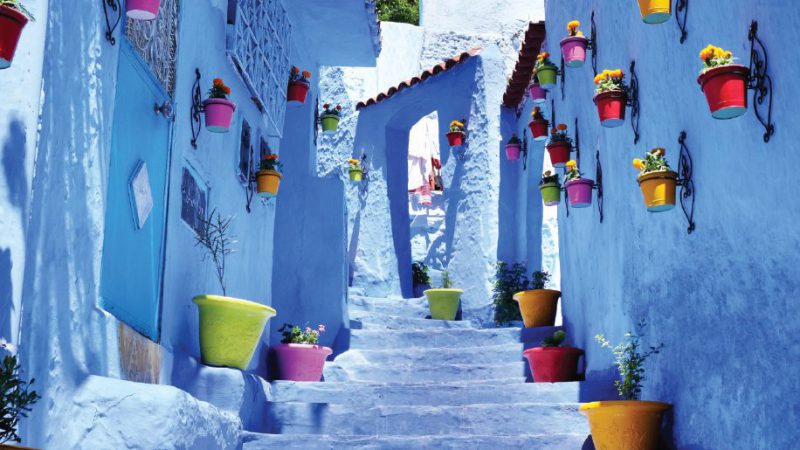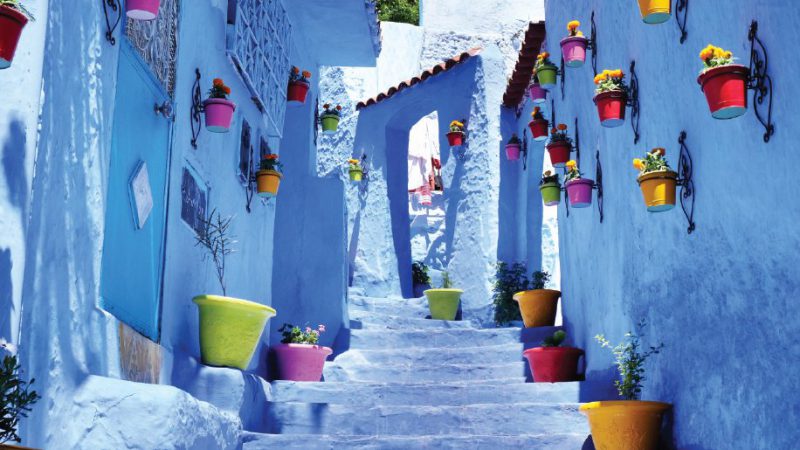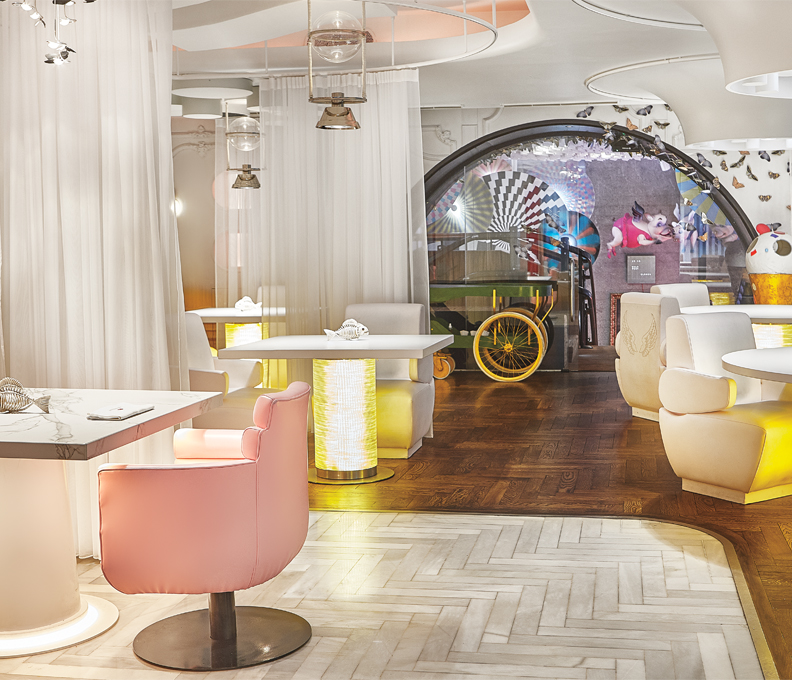Into Africa
Morocco models the future by protecting its past
March 29, 2020

To visit Morocco is still like turning the pages of some illuminated Persian manuscript all embroidered with bright shapes and subtle lines.
– Edith Wharton
Morocco has long been the dim light beckoning across the strait from continental Europe, drawing writers, poets, painters and dreamers to its bustling aromatic cities and its vast empty spaces.
It is where Edith Wharton escaped for an adventurous visit at the end of WWI. No guidebooks; just the tomes of Ibn Buttata to lead the way. It is where Paul Bowles lived for most of his adult life to write such haunting works as The Sheltering Sky, initially prompted to visit the country by his friend, Gertrude Stein, who, herself found inspiration in the North African expanse. More recently, Yves St. Laurent adopted Marrakech as a delectable canvas and made his mark on the local cultural fabric.
Beyond Casablanca
And then there are the countless films, so numerous that the country has its own film office and list of standby medinas to set into action. The ancient clay city of the Aït Benhaddou near Ouarzazate is easily recognized as the city of Unsullied in Game of Thrones (also scenes from Gladiator were filmed here). Orson Welles shot Othello in Essaouira. Hitchcock filmed the Man Who Knew Too Much in Marrakech. Parts of Lawrence of Arabia were filmed in Morocco. Ironically, Casablanca was not.
But the travelers to Morocco these days are less apt to be poets and writers, and more likely to be young Instagrammers salivating over the ubiquitous cerulean dwellings amid desert palms, ferrous mountain rises and snowcapped peaks in a swirl of hues that mix well with the local drapey fashions donned for striking selfie shots.
Due to Instagram, Morocco’s relatively long lasting stability, its commitment to protecting and buoying tourism, and the North African Kingdom’s interest in bridging business enterprise between Africa and Europe, the country has been seeing some good years. Tourism arrivals counted 13 million in 2019, up 5.2 percent from the previous year and contributing $8.16 billion to the country’s economy.
Contemporary Carpets
Expanded airline service, too, has contributed to Morocco’s upward trajectory. Europe remains ever close and affordable with lift from Easyjet and now Ryanair. British Airways, Lufthansa, KLM, and Air France also offer direct and non-stop flights from key gateways in Europe.
From the US, Morocco is back in play with new and expanded service from Royal Air Maroc (RAM) and the first-ever non-stop flight by American Airlines to the African continent. Royal Air Maroc now offers non-stop service to Casablanca from Miami as well as Boston, New York JFK and Washington Dulles. It runs a codeshare with American Airlines to shuttle passengers beyond Casablanca to other destinations in Africa.
And it recently joined the network at oneworld, which brings together 13 airlines and enables RAM to access more than a dozen new hubs as well as 1,035 destinations in 164 countries. Currently, RAM operates 100 air routes – 80 to international airports of which half are in Europe, 32 in Africa and five are in the Middle East.
“Royal Air Maroc is a premier African carrier and their hub in Casablanca is perfectly situated to offer customers convenient connections between North America and over 40 destinations throughout Africa,” said Vasu Raja, American’s senior vice president of network strategy, in a statement about the new service. “With Royal Air Maroc’s upcoming entry into the oneworld alliance and our recently announced service between Philadelphia and Casablanca, we are committed to creating more opportunities for our customers to visit unique destinations in Africa.”
The codeshare agreement allows American’s customers much easier access to more remote destinations in Africa, including:
• Abidjan, Cote d’Ivoire (ABJ)
• Accra, Ghana (ACC)
• Lagos, Nigeria (LOS)
• Luanda, Angola (LAD)
• Monrovia, Liberia (ROB)
American Airlines will fly nonstop from Philadelphia to Casablanca seasonally, starting June 4 through Sept. 8, 2020, on three flights a week running about 7.5 hours in flight time. Gone are the days travelers would have to take up to 40 hours to get from the US to Casablanca on pond and puddle jumps between inconvenient gateways punctuated with long layovers.
Those flying privately will appreciate the new flagship Jetex VIP Terminal at Marrakech Menara Airport, the latest terminal in the bunch that also includes Casablanca, Agadir and Rabat and a smattering of other locations in Africa.
Morocco sees more than 10,000 private jet movements annually and the private terminal caters to the expectations of these travelers with privacy, attendant service and a modern facility furnished with designer pieces by Pritzker Prize winner Zaha Hadid.
Morocco is no stranger to business travelers. Besides tourism, the country is a major exporter of agricultural products and a hub for mining operations. It is now actively attracting corporations to open their continental headquarters here; most recent among them is Orange Group, formerly France Télécom, that is building its regional offices in Casablanca Finance City (CFC), the new business center of Morocco’s economic capital.
“Africa is the future of Orange,” Orange CEO Stéphane Richard told a reporter for Paris-based The Africa Report. “Setting up in Dakar rather than Abidjan would have made the Ivorian side jealous and vice versa. Casablanca has become a communications hub in Africa that meets all our expectations.”
Since the US-Morocco Free Trade Agreement came into effect in 2006, overall annual bilateral trade has increased by more than 250 percent. The United States is Morocco’s fourth largest trading partner and second largest foreign investor. Company names populating Morocco’s global business listings include Faurecia, Resolution Call, Hilti, Comdata, Menara Holding, Teleperformance, DHL Express, Decathlon, EM Lyon Business School Casablanca, Payment Center for Africa, Averda, Societe Generale Africa Technologies & Services, Alten, Chaabi LLD, Hyundai, among others.
Speeding Up and Slowing Down
Whether heading here for business or pleasure, truly seeing Morocco should entail forays into the great ergs or deserts edging the Sahara as well as visits to the country’s four Imperial Cities of Meknes, Marrakech, Rabat and Fez. Tangier is the great port city on the Mediterranean and connected to Morocco’s capital, Rabat, as well as Casablanca, by a new, French built TGV high-speed rail service that launched in 2018. Trains depart from every hour, on the hour, from 6 AM to 9 PM. The 225-mile journey takes just over two hours at speeds reaching 186 mph cutting in half the previous travel time.
No matter what the destination, the visitor will be greeted by a fairyland of color, textures, aromas, timeless movement and stunning urban surrounds that leap straight out of a 20th century film set or 19th century tome about daring explorations in the Sahara.
Perhaps the most mesmerizing of Morocco’s destinations is Marrakech – the Red City. A serene 2.5-hour train ride from Casablanca arrives in a city of dizzying ancient souks flanked by a sprawl of ferrous-hued low rises and minaret towers dotted with palms and set against the shadowy Atlas Mountain range.
Luxury hotels have planted their flags in this city: Four Seasons, Mandarin Oriental, Amanresorts (Amanjena), Fairmont. Marriott has the AnaYela (part of its Design Hotels collection) and Le Méridien N’Fis there. And there are some exquisite properties you will not find anywhere else: Selman Marrakech and La Mamounia.
The latter has a fabled history as it became the domicile of visiting kings and sultans after it opened in 1923, and has not lost its luster or its time-defying nature. It will be closed this summer for a renovation by a Paris-based studio called into overhaul the restaurants and public areas, but will remain an oasis of quiet and beauty just steps away from bustling Djemaa el Fna square, the medina that is the heart of Marrakech.
The four-acre sprawl of Djemaa el Fna is as alive today as it was when it was created in 1062. Narrow stone alleys snake into various neighborhoods bursting with visual, auditory and olfactory shocks: the spice markets; the jewelry markets; the textile kiosks overflowing in cantaloupe-colored scarves and all possibilities of pasha pants; the reptile boutiques (iguanas, chameleons, tarantulas); the intricate carpets woven from the wool of Barbary sheep; the tinkling pours of mint tea; the heady Argan oil attars made from roses, frankincense and musk.
This is a place that demands hours, if not days. Chances are you will get charmed by a snake tamer and wrapped in a live boa. And no doubt the charmer will request dirham to remove it from your neck. But this is all part of the fun – and no, the snake is not dangerous.
Getting lost in the souk is also inevitable and something to be savored. But it need not be eternal. Most merchants speak English and there are many ways out. Just watch for speeding donkeys and listen for the word, “balak!” the warning heard everywhere to get out of the way.
Other top spots in Marrakech include the Majorelle Garden, now an Instagram fave for its villas doused in riveting blue and yellow hues. The 2.5-acre garden, was created by the eponymous Orientalist artist in 1923 and purchased (and restored) by fashion designers Yves Saint-Laurent and Pierre Bergé in the 1980s. The garden houses the Islamic Art Museum of Marrakech, the Berber Museum and now the Yves Saint Laurent Museum.
While Morocco may be roughly the size of California, it packs in the bedazzling topography, the varied history (a visit to Fez will offer an authentic experience and understanding of Morocco and also a glimpse into what Jewish life once was in North Africa), the endless deserts pocked here and there by medieval villages, the endless beaches, the snow-capped mountains, the crowded medinas and the swell of modern industry keeping it all safe, stable and accessible.
Morocco is a friendly place and for those with eyes open and hearts willing, the timeless lessons of history and engagement are there for the taking, pure and simple.




